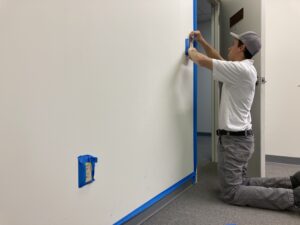There are many reasons why you might be interested in touching-up your walls. Maybe there are scuff marks from furniture, scratches from pets, handprints in stairwells, or even some lovely artwork by your child! Or maybe you are looking to sell your home and just want to hit some trouble spots to give a better overall appearance. Regardless of what your reason is, the question is: “can I touch-up or do I need to repaint?“ Don’t worry, we’ve got the answer!
There are several factors to consider when tackling a touch-up project. These include: how long ago the wall was painted, the sheen/finish of the paint, and how many trouble spots are on the wall. If the paint job is less than a year old, there is a much better chance that a touch-up will be successful. After the year mark, the paint color will often start fading slightly and this makes touch-ups far more visible since even using the original paint will not match perfectly. As the years go by, matching the existing paint color becomes increasingly more difficult. The finish or sheen of the paint also plays an important role. A flat finish is the best bet for making touch-ups blend in while going up in sheen level to an eggshell, satin, or semi-gloss finish makes touch-ups far more noticeable. If you’ve ever noticed some shiny spots on your walls, these are likely from touch-ups! Finally, it is easy to be blinded by that one scuff mark that seems to always be staring you in the face! But we have found that it is often the case that a wall usually has at least several blemishes once you start looking for them. If this is the case, then it can often make more sense to paint the entire wall as opposed to trying to hit the individual trouble spots.
Hiring a professional is sometimes the best way to avoid headaches since we have some methods and tricks to make touch-ups more successful. You can also try using these tips yourself! One way to avoid repainting an entire wall for example is to use the windows and doors as natural break points. Sometimes you can use blue tape to continue the straight lines from window or door frames to section off wall areas and make for less painting! Another method we use is to take a quarter sized sample from the wall and bring it to the paint store to get as precise a match as possible. If the match is really close, sometimes it is possible to tape off around the trim and simply roll the walls as opposed to cutting in. This can also save some time!
The idea that touching-up will solve the problem is often simply not the case unfortunately. Taking a roller and using the leftover paint from 3 or 4 years ago to hit a few spots will likely result in trading the scuff marks you tried to eliminate for visible square patches that catch your eye. It can definitely be a situation where you as the homeowner are trading one headache for another. If you have a wall(s) where the paint job is at least several years old, or if it doesn’t have a flat finish, or if there are multiple imperfections…don’t waste your time with trying a touch-up and plan on painting the whole wall. Too much for you to tackle? Call the pros!
Are you still wondering when and where you can touch-up? Here are some examples of when doing a touch-up might suffice. A new paint project. If your walls were painted within the last year with a flat finish, there is a good chance that touching-up will work just fine! Another circumstance is if the wall in question is in a low light environment like a basement. Sometimes the lack of natural light can help make touch-ups blend in better, especially since the existing paint color won’t have faded due to the sun! A final example we’ve seen where a touch-up can be effective is in spots that are not in the normal field of vision. Scuff marks on baseboards for example can be a location where touching-up with the original paint can definitely work out!
Depending on the details of your project, it might be something that can be touched-up or it might be the case that the whole wall should be painted. Still not sure about your specific project? Feel free to reach out to us and we are happy to provide you with some more information!



